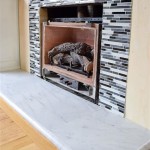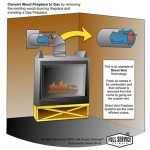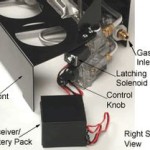Metal Fireplace Mantels: A Comprehensive Guide
The fireplace mantel serves as a focal point within a room, providing both aesthetic appeal and a functional surface for displaying decorative items. Among the diverse materials available for fireplace mantels, metal offers a unique blend of durability, modern aesthetics, and design versatility. This article explores the characteristics, advantages, considerations, and installation aspects of metal fireplace mantels.
Metal mantels can transform a fireplace from a simple functional element into a statement piece. Their sleek lines and ability to be shaped into various forms allows them to complement many interior design styles, from minimalist modern to industrial chic. The material's inherent strength ensures longevity, and its diverse finishes can be tailored to specific aesthetic preferences.
Durability and Longevity of Metal Mantels
One of the primary benefits of metal fireplace mantels is their exceptional durability. Unlike wood mantels, which can be susceptible to moisture damage, warping, and insect infestation, metal is inherently resistant to these factors. This resilience makes metal a practical choice for fireplaces that see frequent use. Properly treated metal mantels can withstand high temperatures, minimizing the risk of damage from direct heat exposure.
The longevity of a metal mantel is also a significant advantage. When fabricated from materials like steel or iron and adequately coated with a protective finish, a metal mantel can last for decades with minimal maintenance. This long lifespan translates to a worthwhile investment, as it reduces the need for frequent repairs or replacements.
The resistance to physical damage is another key factor. Unlike softer materials, metal is less prone to scratches, dents, and other blemishes from accidental impacts. This robustness makes it particularly suitable for households with children or pets, where furniture is more likely to experience wear and tear.
Furthermore, metal is resistant to mold and mildew growth. This makes it a superior choice for environments that are prone to humidity or moisture. Wood mantels, on the other hand, can become breeding grounds for these organisms if not properly sealed and maintained. Using a metal mantel, therefore, can contribute to a healthier indoor environment.
Aesthetic Versatility and Design Options
Metal fireplace mantels offer a wide range of aesthetic possibilities for interior design. The material's inherent malleability allows it to be shaped into various forms, from clean, minimalist lines to intricate, decorative patterns. This versatility allows homeowners to customize their fireplace mantels to match their specific décor style.
Different types of metals offer distinct visual characteristics. Stainless steel provides a sleek, modern look, while wrought iron evokes a more traditional and rustic feel. The choice of metal can significantly influence the overall aesthetic of the fireplace and the room.
Finishes also play a crucial role in the appearance of metal mantels. Powder coating is a popular option that provides a durable and aesthetically pleasing finish in a wide range of colors. Brushed finishes can add a subtle texture and depth, while polished finishes create a glossy, reflective surface.
Metal can be combined effectively with other materials, such as wood, stone, or glass, to create visually striking fireplace mantel designs. For example, a metal frame surrounding a wooden mantel shelf can provide a modern contrast, while a metal mantel paired with a stone fireplace surround can create a sense of rustic elegance.
The thin profile achievable with metal allows for minimalist designs that maximize space. In smaller rooms, a slim metal mantel can provide a functional surface without overwhelming the space. Conversely, larger metal mantels can serve as bold statement pieces in grand living rooms.
Installation Considerations and Safety Measures
Installing a metal fireplace mantel requires careful planning and attention to safety. Proper installation is crucial to ensure the mantel's stability and prevent any fire hazards. It is recommended that a qualified professional perform the installation, especially if modifications to the existing fireplace structure are required.
Before installation, it is essential to assess the structural integrity of the fireplace surround and the wall to which the mantel will be attached. The wall must be capable of supporting the weight of the metal mantel, especially if it is a larger or heavier design. Reinforcement may be necessary in some cases.
Clearance from the firebox is a critical safety consideration. Building codes typically specify minimum distances that combustible materials, including mantels, must be from the opening of the firebox. Ensure that the metal mantel complies with these requirements to reduce the risk of fire.
When attaching the mantel to the wall, use appropriate fasteners that are designed for the wall material (e.g., concrete anchors for masonry walls, lag screws for wood studs). The fasteners should be strong enough to support the weight of the mantel and any items placed on it.
If the mantel is designed to conduct heat, consider installing a heat shield to protect the wall behind it. This is particularly important if the wall is made of combustible materials. Heat shields can deflect heat away from the wall, preventing it from overheating and potentially causing a fire.
Inspect the installed mantel regularly for any signs of damage or wear. Check the fasteners to ensure they are still secure, and be on the lookout for any cracks or deformations in the metal. Promptly address any issues to maintain the mantel's safety and structural integrity.
During the installation process, wear appropriate safety gear, such as gloves and eye protection. Metal can have sharp edges, and dust and debris can be generated during drilling and cutting. Protect yourself from potential injuries by using the correct safety equipment.
Consider the expansion and contraction properties of metal when installing the mantel. Metal expands when heated and contracts when cooled, so allow for some movement during installation to prevent stress on the mantel and surrounding structure.
For gas fireplaces, consult the manufacturer's instructions regarding mantel placement and heat deflection. Gas fireplaces can generate significant heat, and it is crucial to ensure that the mantel is positioned safely to avoid any fire hazards.
If the metal mantel incorporates electrical components, such as integrated lighting, ensure that all wiring complies with local electrical codes. Hire a qualified electrician to perform any electrical work to ensure safety.
Always take fire safety precautions during fireplace use, regardless of the mantel material. Keep flammable materials away from the fireplace, and never leave a fire unattended. Install a smoke detector and carbon monoxide detector in the vicinity of the fireplace to provide early warning in case of a fire or carbon monoxide leak.
Metal fireplace mantels offer a compelling combination of durability, aesthetic versatility, and safety features, making them a popular choice for homeowners seeking a modern and functional fireplace design. By carefully considering the material, design, and installation aspects, one can create a stunning fireplace focal point that enhances any living space.

Mantels Direct 68 In W X 2 5 H 12 D Black Metal Contemporary Fireplace Mantel The Department At Com

Chesapeake Old World Banding Steel Fireplace Mantel Shelf

Choosing A Fireplace Mantel Which Look Is Right For You

Steel Fireplace Mantel Shelf You Can Customize To Preference

Modern Fireplace Mantel Shelf In Brushed Stainless Steel

Rustic Mantel With Metal Straps Fireplace Mantle Mantels

Steel Mantel Shelf Is Noncombustible

Magnetic Mantel Metal Fireplace Powder Coat

Custom Fireplace Mantels Stoll Industries 50 Years Experience

Shelves Mantels Stoll Industries
Related Posts








